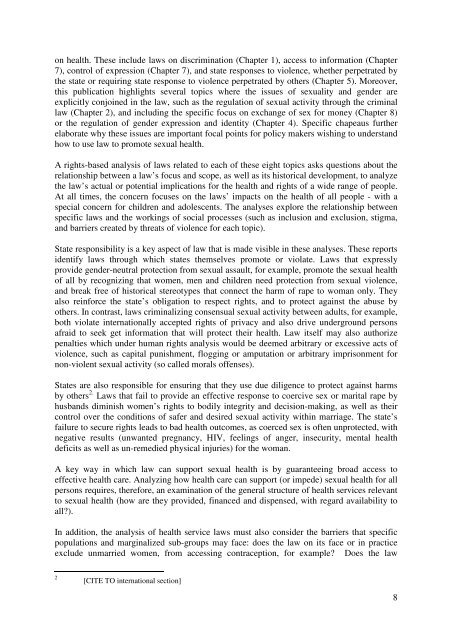SEXUAL HEALTH AND HUMAN RIGHTS A legal and ... - The ICHRP
SEXUAL HEALTH AND HUMAN RIGHTS A legal and ... - The ICHRP
SEXUAL HEALTH AND HUMAN RIGHTS A legal and ... - The ICHRP
Create successful ePaper yourself
Turn your PDF publications into a flip-book with our unique Google optimized e-Paper software.
on health. <strong>The</strong>se include laws on discrimination (Chapter 1), access to information (Chapter<br />
7), control of expression (Chapter 7), <strong>and</strong> state responses to violence, whether perpetrated by<br />
the state or requiring state response to violence perpetrated by others (Chapter 5). Moreover,<br />
this publication highlights several topics where the issues of sexuality <strong>and</strong> gender are<br />
explicitly conjoined in the law, such as the regulation of sexual activity through the criminal<br />
law (Chapter 2), <strong>and</strong> including the specific focus on exchange of sex for money (Chapter 8)<br />
or the regulation of gender expression <strong>and</strong> identity (Chapter 4). Specific chapeaus further<br />
elaborate why these issues are important focal points for policy makers wishing to underst<strong>and</strong><br />
how to use law to promote sexual health.<br />
A rights-based analysis of laws related to each of these eight topics asks questions about the<br />
relationship between a law’s focus <strong>and</strong> scope, as well as its historical development, to analyze<br />
the law’s actual or potential implications for the health <strong>and</strong> rights of a wide range of people.<br />
At all times, the concern focuses on the laws’ impacts on the health of all people - with a<br />
special concern for children <strong>and</strong> adolescents. <strong>The</strong> analyses explore the relationship between<br />
specific laws <strong>and</strong> the workings of social processes (such as inclusion <strong>and</strong> exclusion, stigma,<br />
<strong>and</strong> barriers created by threats of violence for each topic).<br />
State responsibility is a key aspect of law that is made visible in these analyses. <strong>The</strong>se reports<br />
identify laws through which states themselves promote or violate. Laws that expressly<br />
provide gender-neutral protection from sexual assault, for example, promote the sexual health<br />
of all by recognizing that women, men <strong>and</strong> children need protection from sexual violence,<br />
<strong>and</strong> break free of historical stereotypes that connect the harm of rape to woman only. <strong>The</strong>y<br />
also reinforce the state’s obligation to respect rights, <strong>and</strong> to protect against the abuse by<br />
others. In contrast, laws criminalizing consensual sexual activity between adults, for example,<br />
both violate internationally accepted rights of privacy <strong>and</strong> also drive underground persons<br />
afraid to seek get information that will protect their health. Law itself may also authorize<br />
penalties which under human rights analysis would be deemed arbitrary or excessive acts of<br />
violence, such as capital punishment, flogging or amputation or arbitrary imprisonment for<br />
non-violent sexual activity (so called morals offenses).<br />
States are also responsible for ensuring that they use due diligence to protect against harms<br />
by others 2. Laws that fail to provide an effective response to coercive sex or marital rape by<br />
husb<strong>and</strong>s diminish women’s rights to bodily integrity <strong>and</strong> decision-making, as well as their<br />
control over the conditions of safer <strong>and</strong> desired sexual activity within marriage. <strong>The</strong> state’s<br />
failure to secure rights leads to bad health outcomes, as coerced sex is often unprotected, with<br />
negative results (unwanted pregnancy, HIV, feelings of anger, insecurity, mental health<br />
deficits as well as un-remedied physical injuries) for the woman.<br />
A key way in which law can support sexual health is by guaranteeing broad access to<br />
effective health care. Analyzing how health care can support (or impede) sexual health for all<br />
persons requires, therefore, an examination of the general structure of health services relevant<br />
to sexual health (how are they provided, financed <strong>and</strong> dispensed, with regard availability to<br />
all?).<br />
In addition, the analysis of health service laws must also consider the barriers that specific<br />
populations <strong>and</strong> marginalized sub-groups may face: does the law on its face or in practice<br />
exclude unmarried women, from accessing contraception, for example? Does the law<br />
2<br />
[CITE TO international section]<br />
8

















